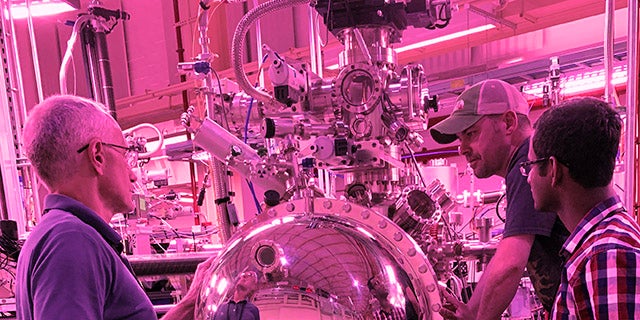Graduate studies in physics at URI began in 1949, when the department was first authorized to grant master’s degrees. The doctoral program was started in 1964. The department has active research programs in a broad range of areas, and each research program is headed by a faculty member. Some programs have overlapping components because of intra-departmental collaborations.
The research groups are listed below for both theoretical and experimental areas.
Research Interests of URI Physics Faculty
Astrophysics: The URI Quasar Group focuses on making multiwavelength images of high redshift quasars to investigate their morphological properties, evolution over time, and their energy production mechanisms. Imaging is done primarily using the Very Large Array (VLA) in New Mexico, the Chandra X-ray space telescope, and the Sloan Digital Sky Survey (SDSS).
Biological physics: membrane biophysics; membrane-associated folding/unfolding; molecular motors; steady-state and kinetics fluorescence and circular dichroism studies; calorimetry; small angle x-ray scattering on biological objects (at the European Synchrotron Radiation Facility, Grenoble); fluorescence microscopy; fluorescence polarization microscopy; spectral analysis from cells; electric cell substrate impedance sensing on cells.
Computational physics: classical and quantum Monte Carlo methods, large-scale parallel computations, optimization, many-body interactions and invariants, finite-size scaling.
Experimental condensed matter physics: electronic and structural properties of surfaces and thin films studied via low-energy electron diffraction, Auger electron spectroscopy, photoemission techniques (in-house and at the Brookhaven National Laboratory synchrotron facility); surfaces and interfaces in thin films and multilayers studied via X-ray and neutron reflection and diffraction (in-house and at the National Institute of Standards and Technology reactor facility); epitaxial growth, magnetism in nanoparticles and on surfaces via neutron and X-ray scattering; characterization of Lithium Ion Batteries using Hard X-ray Photoemission Spectroscopy (HAXPES), Rutherford backscattering, and scanning tunneling microscopy; ultrafast dynamics of hot carriers in 2-dimensional materials studied with multi-color femtosecond spectroscopy; phonon decay and vibrational dynamics in traditional and soft condensed matter studied by coherent Raman spectroscopy techniques; sub-optical cycle waveform generation.
Medical physics, physics oncology and nanotechnology: novel approaches in drug delivery and tumor targeting; whole-body and ex vivo fluorescence imaging; gold and magnetic nanoparticles; laser and x-ray radiation; hyperthermia; liposome delivery.Visit the Biological Research Group website for more.
Relativity & gravitation: Einstein’s general relativity theory, curved space-time geometry, gravitation, black holes, gravitational waves, singularities, loop quantum gravity and quantum geometry. Visit Gravity Research Group website for more.
Statistical physics: Bethe ansatz, density functional theory, fractional exclusion statistics, applications to spin systems, quantum gases, granular matter, and biological matter.
Theoretical condensed matter physics: surface physics, phase transitions and critical phenomena, critical dynamics, superconductivity, quantum transport, systems with random rough boundaries, nano-scale films and clusters, disordered systems, low-dimensional systems, spin dynamics, nonlinear optics.
Theoretical low-temperature physics: Fermi and Bose quantum liquids, solids and gases; spin-polarized quantum systems, ultracold neutrons in quantizing gravity field.
Theoretical Research Groups
| Leonard M. Kahn | Quantum Computing and theoretical condensed matter physics
|
|
| Gaurav Khanna |
|
|
| Gerhard Müller | Theoretical condensed matter physics
|
Nonlinear dynamics and chaos
|
| Michael Tammaro | Physics Education
|
|
| Aidan Chatwin-Davies
|
|
|
| Wenchao Ge
|
|
|
| Vanita Srinivasa
|
|
Experimental Research Groups
| Oleg A. Andreev | Biological Physics
|
Medical Physics, Physics Oncology and Nanotechnology
|
| Michael Antosh |
|
|
| Feruz Ganikhanov |
|
|
| David R. Heskett | Experimental condensed matter physics
|
|
| Yana Reshetnyak | Biological Physics | Physics Oncology
|
| Douglas Gobeille |
|
|
| Rob Coyne | Gravitational Wave Astrophysics
High Performance Computing
|
|
 URI Homepage
URI Homepage










